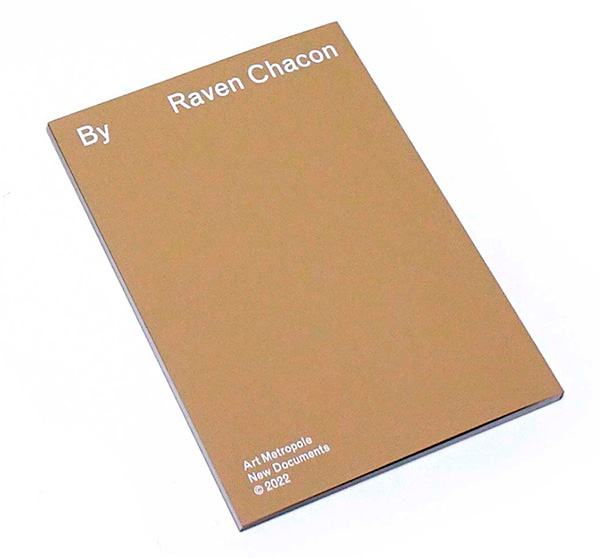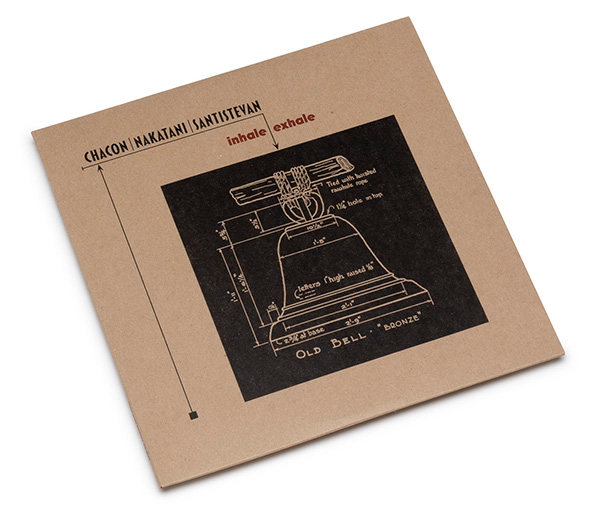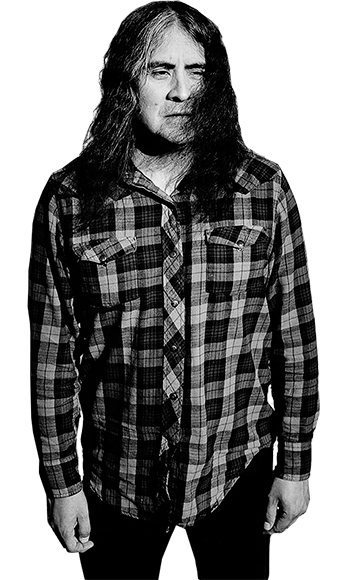Raven Chacon
The New Mexico based performer, improvisor, composer, and sound artist Raven Chacon is having a pretty remarkable year. Not only was his work included in the latest incarnation of the Whitney Biennial, but he was awarded the Pulitzer Prize in Music. In many ways, it feels like the vindication of a deeply personal body of work, that has carved its own path over the last 20 years. These happenings also served as a reminder that access to Chacon’s work and ideas remains scant at best, making New Documents and Art Metropole’s joint publication of “For Zitkála-Šá” a truly remarkable event.

Paying tribute to Yankton Dakota writer, musician, and activist, Zitkála-Šá (1876-1938), this stunning book gathers a series of scores created by Chacon for thirteen contemporary female Indigenous performing artists, placed in conjunction with texts by each artist - Laura Ortman, Cheryl L’Hirondelle, Suzanne Kite, Barbara Croall, Jacqueline Wilson, Autumn Chacon, Heidi Senungetuk, Ange Loft, Joy Harjo, Carmina Escobar, Olivia Shortt, Candice Hopkins, and Buffy Sainte-Marie - and a contextualizing essay by the composer. If that wasn’t enough, we’ve also just gotten copies of Chacon’s beautiful collaborative LP with Tatsuya Nakatani and Carlos Santistevan, “Inhale/Exhale”, that just dropped via the venerable imprint Other Minds. A wild, textural improvisation that transforms the sounds guitar, bass, and drums into otherworldly expanses, it’s a stunner that illuminates another side of Chacon’s practice, and his long-standing connections metal and noise. As free-standing objects, or pieces of the puzzle, both “For Zitkála-Šá” and “Inhale/Exhale” are stunning objects, offering further access to one of the most engaging practices in the contemporary landscape of sound.
Raven Chacon "For Zitkála-Šá" (Book)
Raised in Fort Defiance, Navajo Nation, Arizona, and a student of James Tenney, Morton Subotnick, Michael Pisaro and Wadada Leo Smith at CalArts, for the last 20 years Raven Chacon has bridged the creative realms of chamber music, noise, site specific installation, and performance, building a body of singular solo efforts, as well as a critically heralded collaborative works within the collective Postcommodity.

Deeply introspective, Chacon’s work rests at the root of meaning and intention of experimental practice. It is the outcome of an action which responds to a question for which, at inception, the answer is unknown. In his hands, sound is a raw, democratic material, with a near infinite number of possibilities and sources - sometimes found and encountered, others self-generated - reformed into an image that refracts the notion of humanity and being outside of itself.
Like many artists of his generation and context, Chacon’s roots lay within underground cultures of music, notably metal and noise, but as his career has progressed he has slowly begun to incorporate deeply conceptual elements that take form through scored - noted, text based, and graphic - elements - “Voiceless Mass”, the work for which he received the Pulitzer, being one such case.


It is this realm of Chacon’s practice that the volume, “For Zitkála-Šá”, draws us into. The book’s title points toward the social and political legacy to which Chacon belongs, navigating, through creative action, the complexities of meaning for the indigenous peoples of the Americas, against the unabating legacies of colonialism that echo within the present.
Via scores for thirteen contemporary female Indigenous performing artists - Laura Ortman, Cheryl L’Hirondelle, Suzanne Kite, Barbara Croall, Jacqueline Wilson, Autumn Chacon, Heidi Senungetuk, Ange Loft, Joy Harjo, Carmina Escobar, Olivia Shortt, Candice Hopkins, and Buffy Sainte-Marie - it pays tribute to the Yankton Dakota writer and musician, Zitkála-Šá, who is regarded as one of the most influential Native American activists of the 20th Century, drawing particular attention to the complexities of cultural identity within the United States.


While Chacon’s referencing of Zitkála-Šá, in conjunction with composing for female artists, may appear to belong to a contemporary narrative of feminist practice, the reality may be slightly more dynamic. Patriarchy does not traditionally exist within many Native American cultures, a fact illuminated by anthropologist and activist Lewis H. Morgan - a rough contemporary of Zitkála-Šá and honorary member of the Seneca Iroquois tribe - whose highly influential book, “Ancient Society”, laid the groundwork for Friedrich Engels’ “The Origin of the Family, Private Property and the State”, which eventually became a foundational text for many second-wave feminist thinkers. Morgan’s work indicated the strong presence of a matriarchal / matrilineal social order within a great many Native American tribes, and used this as a proof that patriarchy was not a natural default, as is all too often presumed, in social organization and power structures. In this light, the fact that the Navajo - the tribe to which Chacon belongs - are a matrilineal culture, indicates the possibility of a different kind of politic and poignancy in his choice to compose for women, not so different from Zitkála-Šá’s struggle between her relationship to her own cultural identity and what feels natural within it, and oppressiveness of the values imposed by the power structures of the United States.

The 13 scores comprised by “For Zitkála-Šá” - ranging between text and graphic - are beautiful objects in their own right; elegant, poetic, and concise, leaving infinite space for the voices and temperaments of the artist for which they were composed. Each is accompanied in conjunction with texts by each artist and a contextualizing essay by the composer. Beautifully produced and printed by New Documents and Art Metropole, it entirely shifts what we can regard as collaborative practice and political action within the arts, as well as offering invaluable insight and access to one of the most engaging practices in the contemporary landscape of sound.

Raven Chacon, Tatsuya Nakatani, Carlos Santistevan "Inhale/Exhale" (LP)
For more than 20 years, Other Minds, the San Francisco based record label run by the composer, Charles Amirkhanian, has left an indelible mark on the landscape of American music, championing some of the most ambitious and exciting sounds from across the globe. For most of their run, Other Minds has focused primarily on work fairly closely aligned with avant-garde classical and new music, making their release of “Inhale/Exhale”, a collaboration between Raven Chacon, Tatsuya Nakatani, Carlos Santistevan, particular interesting, given that it bears a stronger relationship to noise. Given that Chacon’s background has been well covered in the above, it’s worth mentioning that Nakatani is a Japanese percussionist, composer, and sound artist, currently based in New Mexico. His decidedly avant-garde practice is centered around arrangement of layers of silence and texture, generated by bowed gong and an array of drums, cymbals, and singing bowls. He’s collaborated with nearly everyone under the sun - Victoria Shen, Audrey Chen, John Edwards, Rafael Toral, William Parker, Billy Bang, and numerous others. The bassist, Carlos Santistevan, is also based in New Mexico, and is most well-known for his work in The Late Severa Wires, with Mike Rowland, Ultraviolet, and Yozo Suzuki.

The trio of Chacon, Nakatani, and Santistevan first came together at October of 2020, in Sante Fe, for a satellite event for Baltimore’s High Zero. The event was a success and deeply felt by all those involved and they fully intended to release a recording of it as an LP, until the hard drive that contained the performance was stolen from Santistevan’s car. The trio quickly made plans to hold another recording session in the same space as the original, San Miguel Chapel, the oldest church in the United States. The LP before us is the document of that session.

Appearing visceral and raw, as well as delicate and considered, “Inhale/Exhale” rides a tense line between minimalism, noise, electroacoustic music, and free improvisation, intertwining bristling textures and tonalities into a kind of ambient scream. Nakatani’s frenetic percussion provides a foundation for the buzzsaw swarm of stringed instruments from Chacon and Santistevan. Throughout the two improvisations that respectively occupy the LP’s sides, beats and crashes map the space, the adobe walls offering a muted and earthen resonance, with the trio’s unique sonic imprint drawing heavily upon the different practices and histories of each player.
Covering a vast amount of ground, without losing cohesion across the album’s length, Chacon, Nakatani, and Santistevan have produced a marvel of visceral noise with “Inhale/Exhale” that is both deeply engaging and not for the faint of heart. Issued on vinyl by Other Minds as a beautifully produced edition, not only does it shine light on important aspects of present practice and roots, but also the wild things brewing in New Mexico’s thriving contemporary scene.


